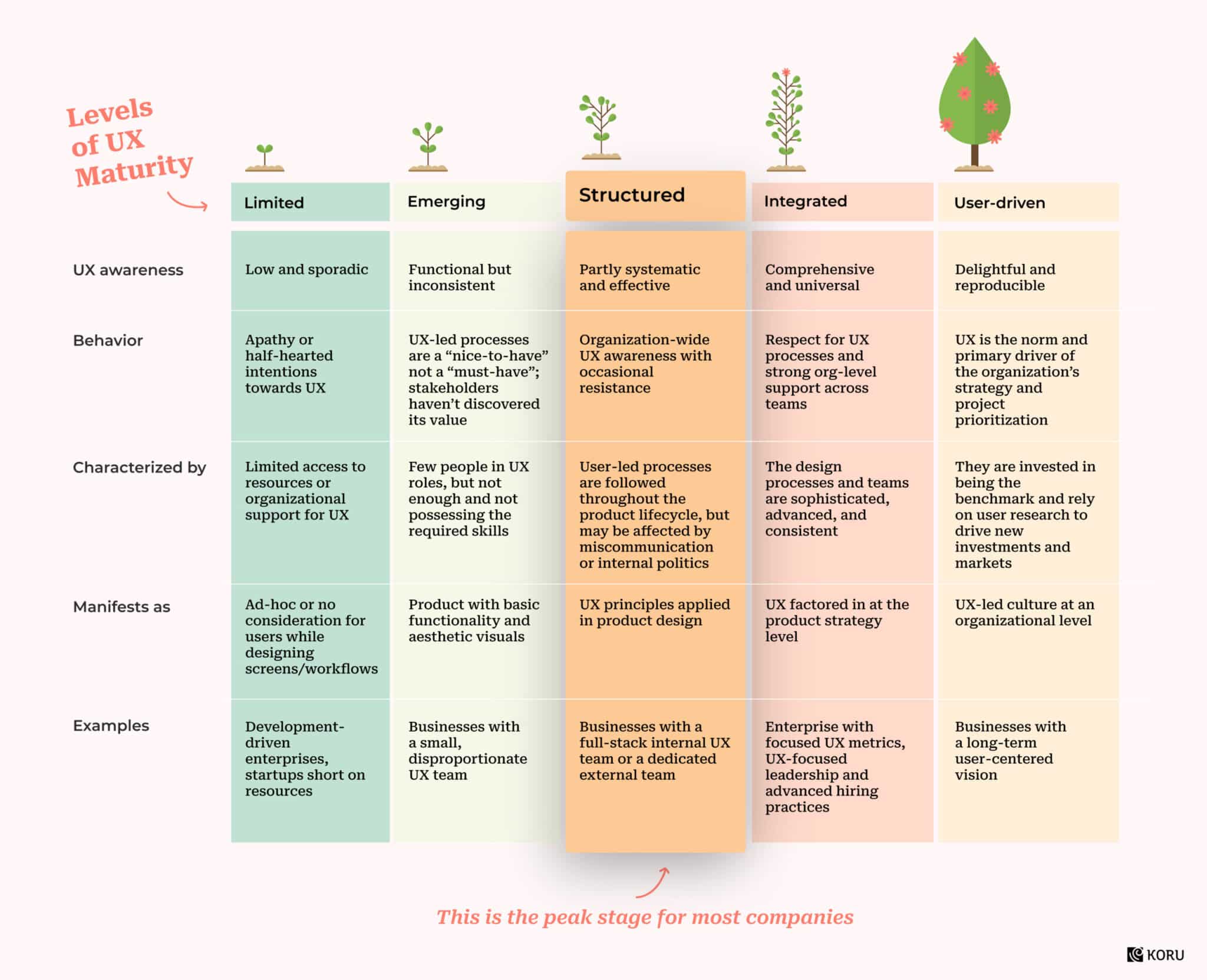Here we go, again.
It’s that time of year when we’re looking forward to the holidays and in a mad rush to tick off every item on our year-end to-do list. A list that includes product budgeting for the next year.
The endless number crunching. The prioritizing. Then arguing with stakeholders, and redoing it all over again.
Every dollar’s worth of expense is a fight, and spending 30% of the budget on “simply asking questions” (read: UX research) can be a hard sell.
So, how do you ensure that UX gets its due in terms of investment? How do you plan to set aside a budget to enhance product performance and user satisfaction?
We are here to help you with points you need to consider before you actually put a figure into your UX budget. These thoughtful considerations will ensure that you have the correct assessment of your company’s UX maturity, your product’s current standing, future needs, and your user requirements – all of which will form the foundation of your UX budget.
6 Questions to answer before you set a UX budget
Ask yourself these before you set your foot forward for setting a UX budget –
How does your organization fare on the UX maturity scale?
Understanding your organization’s UX maturity is the first, most crucial step toward recognizing the strengths and weaknesses of your organization. It helps in identifying what’s working well and continuing it, whilst also acknowledging the wrongs and putting an end to them. Even if the UX efforts in your company seem to be going well, there is always scope for continued assessment and improvisation.

Why is it important to assess organizational UX maturity before setting down a budget?
According to the NN group,
UX maturity measures an organization’s desire and ability to successfully deliver user-centered design. It encompasses the quality and consistency of research and design processes, resources, tools, and operations, as well as the organization’s propensity to support and strengthen UX now and in the future, through its leadership, workforce, and culture.
Amazon’s deliberate decision to invest more in UX than advertising in its early years showed its organizational commitment to delivering good experiences to its customers – a decision that established it as the e-commerce behemoth of today.
Understanding your organization’s UX maturity is crucial as it helps uphold and reward what’s done well, and improve what’s lacking. Even if UX work seems fine at your organization, know that there are still some things to set a budget for, like improving the product’s creation process, or your customers’ and users’ experiences.
Have you defined your short-term and long-term product goals?
Don't users expect a higher quality of experience from something that they pay for vs something that is free?
— Juicy Salif (@angrydesigner_) December 11, 2023
Curiously, many consumer startups allocate large ux budgets for the free parts of their products, & surprisingly little towards the ux journeys after initial conversion.
In 2021, pizza restaurant chain Domino’s was found guilty of violating the Americans with Disabilities Act (ADA) as its website was found to be inaccessible to the blind. The California federal trial court passed an order for Domino’s to bring its website into compliance with the WCAG 2.0 guidelines, following a suit filed by a blind individual (source).
What do you think the immediate priority of the decision-makers at Domino’s would be?
Not to say that companies require lawsuits to open their eyes to obvious flaws in their product, but it’s always a good idea to avail of a comprehensive UX audit to know where your product stands. A UX audit is an expert assessment of your product’s usability and user experience. It involves examining the existing user journeys to reveal actionable areas of improvement. It’s a great tool that aids informed decision-making about what journeys are to be prioritized. It also helps in saving on directionless development costs.
CEO of Torch Digital Labs, Liam Mooney, also a product management veteran, reveals how defining product goals requires an accurate understanding of where you are in the product life cycle.
“For a company that’s trying to retain customers, making the product easier to use and more efficient is likely a priority and therefore, warrants a focus on UX. For one that’s just starting to build a new product or feature to open up the market needs to invest well in good user research and testing. It’s important to consider what the priority of the business is in the coming year to help you determine where your product budget goes.”
Have you defined the design problem at hand?
“We’re looking to scale up our operations.”
“The aim is to expand our user base.”
Sure, these are nice goals to have, but they are a bit vague when you’re at the budgeting stage. A user experience project is all about solving the most pertinent problems plaguing your product and impacting your users. When you define the problem you are tackling with accuracy, you’ll find it easier to estimate your UX budget. For example,
“Ticket resolution times have increased by 9% in the last quarter.”
The design thinking methodology advises taking all things into consideration while defining a design problem. We’ve created a list of 100+ questions to ask before a UX project, which will help you take all aspects into account and help you define the right problem, prep for all possible eventualities, and have clear expectations, goals, and KPIs – everything you need while budgeting for your UX project.
This level of clarity ensures that your objectives are well-defined, and therefore, well-budgeted.
Have you prioritized the design problems to be solved in your product roadmap?
A product roadmap is a guiding document that details how your product strategy is to be transformed into a reality. The roadmap has several competing priorities that boil down to what’s most important, leaving ornamental upgrades by the wayside in favor of what the stakeholders truly care about.
For example,
- You’re looking to design a brand-new product from scratch – your roadmap will contain a time-bound list of objectives, their success metrics, and the plan for when the team will accomplish them.
- If a merger or acquisition has left your product experience broken and visually inconsistent, your roadmap will have a shorter-term view of upcoming UI upgrades with associated goals and epics.
Thus, there is no rule of thumb such as “dedicate 30% of project budgets to UX,” because each project will have its specific priorities, challenges, and objectives that call for different levels of UX input. However, having prioritized goals on your product roadmap allows you to diligently set a realistic budget for UX.
Have you envisioned a timeline for your design project?
There isn’t a magic number of weeks or months that defines an ideal timeline for a UX project. It entirely depends on the number and size of features and development deadlines. However, if one were to provide a ballpark, implementing a user experience process adds about three months to the front end of your project – which of course saves you from tremendous amounts of development rework typically found after release.
But how does one come down to estimating at least a somewhat accurate timeline? Well, this is where your UX audit report comes in handy again. UX audits are mistakenly believed to reveal a ton of work that needs to be carried out right away. Not true! A well-curated audit report comprises a list of improvements that can be taken up in an order of priority. These can be worked upon in an agile fashion, typically in blocks of 2-6 weeks at a time, saving even more money by reducing urgency over time.
How does one prepare for UX contingencies?

Oftentimes, UX in most companies tends to be understaffed and solves some of the more opaque problems the product faces. Therefore, we spoke with Liam Mooney again to get a real-world solution to prepping for any contingencies,
- Cross-train your team members to conduct UX research activities or user testing if you have multiple products or portions of a large product.
- You may also look to hire freelancers or agencies to support your senior team members and make sure you are learning from/adjusting roadmaps as required.
- Avoid delays due to team burnouts: Make sure you are supporting your product team so they can focus and innovate and look for mentorship/training opportunities for them whenever possible.
Clare-Marie Karat, an HCI design specialist and former IBM researcher said, “For every dollar invested in User Experience research, you save $10 in development and $100 in post-release maintenance”. While we’re now at a point in time where most businesses are aware of the excellent ROI that comes with spending on UX—most remain hesitant to commit to it. This is how you kick-start your organization’s transformative UX journey.









